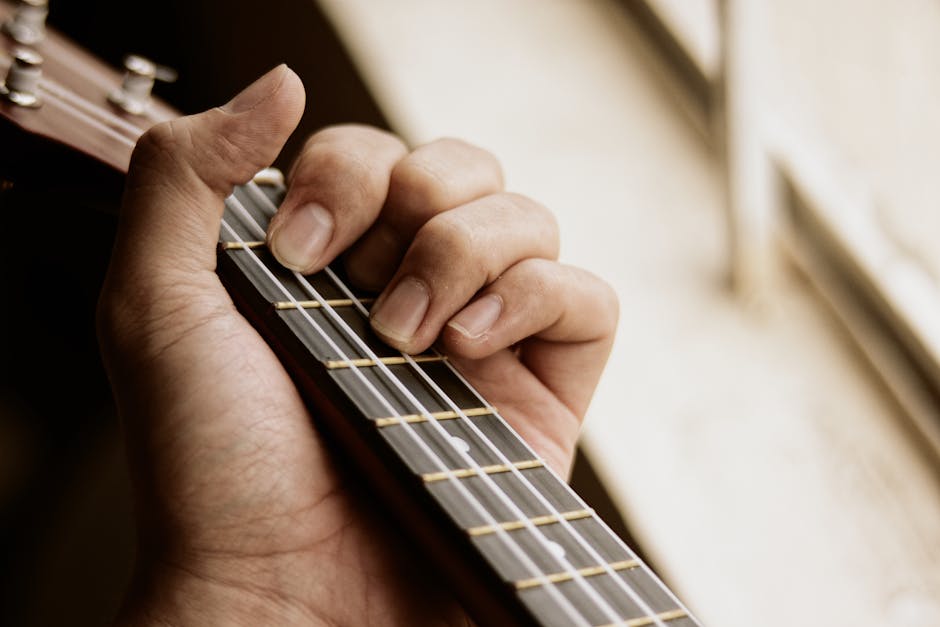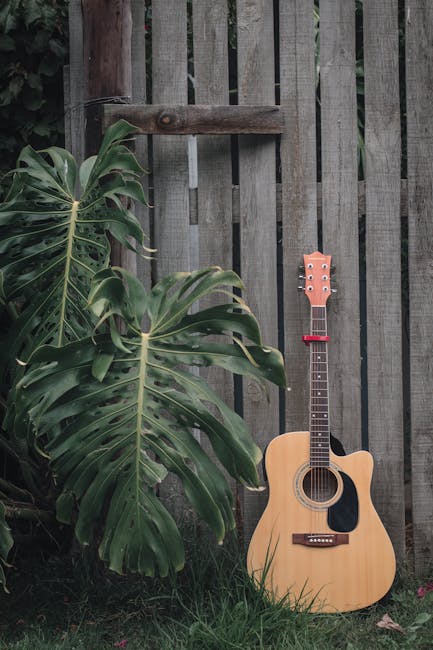Welcome to the world of guitar playing, where seemingly simple concepts can sometimes feel like cracking a secret code. One such puzzle that often leaves aspiring musicians scratching their heads is the mysterious realm of intervals. Like the equivalent of musical building blocks, intervals are the key to unlocking the secrets of harmonious guitar playing. So grab your decoder ring and get ready to master the art of decoding intervals to create some seriously impressive music blocks on your guitar.
Contents
- 1 Understanding the Foundation: The Role of Intervals in Guitar Music
- 2 Exploring Intervals: The Building Blocks of Melody and Harmony
- 3 Major and Minor Intervals: Characterizing Music’s Mood
- 4 Navigating the Fretboard: Visualizing Intervals on Guitar
- 5 Practical Exercises: Developing Interval Recognition and Application
- 6 Crafting Your Musical Language: Composing with Intervals
- 7 Enhancing Improvisation Skills Through Interval Mastery
- 8 FAQs
- 9 Until Next Time, Keep Rockin’!
Understanding the Foundation: The Role of Intervals in Guitar Music
Intervals in guitar music are like the bread and butter of the musical sandwich – they hold everything together and make it oh so delicious. Without intervals, our music would sound as disjointed as a toddler’s attempt at finger painting. So, let’s dig deep into the role of intervals in creating those sweet melodies and killer riffs.
Picture this: you’re playing a killer solo on your guitar, shredding away like a rock god. What’s making those notes flow seamlessly from one to the next? Intervals, my friends. These little guys determine the distance between two notes and give your music that smooth, harmonious sound.
But wait, there’s more! Intervals also play a crucial role in creating tension and resolution in your music. Want to build up the intensity of your solo? Throw in a major seventh interval to keep your listeners on the edge of their seats. Need to give them that sweet release? Resolve that tension with a perfect fifth and watch the magic happen.
So, next time you’re jamming out on your guitar, take a moment to appreciate the humble interval. They may be small, but they sure do pack a punch when it comes to creating killer music.
Exploring Intervals: The Building Blocks of Melody and Harmony
Intervals are like the Legos of music – they’re the building blocks that come together to create beautiful melodies and harmonies. Whether you’re a seasoned musician or just starting out, understanding intervals is key to unlocking the secrets of music theory.
Think of intervals as the distance between two notes on a musical staff. They can be measured in half steps and whole steps, each one having its own unique sound and feel. From the haunting sound of a minor second to the uplifting sound of a major seventh, intervals add color and depth to music.
Exploring intervals is like going on a scavenger hunt through the world of music. You never know what treasures you’ll uncover along the way – maybe you’ll stumble upon the perfect harmony for a song you’re writing, or discover a new way to spice up an old melody. The possibilities are endless!
- Major Second: Known for its cheery and bright sound, this interval is like a ray of sunshine in a musical landscape.
- Perfect Fifth: The powerhouse of intervals, this one adds strength and stability to any melody or chord progression.
- Diminished Fourth: With its mysterious and unsettling vibe, this interval is perfect for adding a touch of drama to your music.

Major and Minor Intervals: Characterizing Music’s Mood
When it comes to music, major and minor intervals are like the yin and yang of the musical world. They are the peanut butter and jelly, the macaroni and cheese, the Batman and Robin of harmonies. Major intervals are like a sunny day at the beach, while minor intervals are more like a rainy day stuck indoors.
Major intervals have a cheerful and uplifting quality to them, like a bubbly pop song that makes you want to dance. On the other hand, minor intervals have a darker and more melancholic feel, like a sad country ballad about lost love and broken hearts.
Major intervals are all about sunshine and rainbows, while minor intervals are all about storm clouds and thunder. Major intervals are like a warm hug from your best friend, while minor intervals are like a lonely walk in the pouring rain. In the end, major and minor intervals work together to create the vast spectrum of emotions that make up the soundtrack of our lives.

So you’ve mastered the basic chords and scales on the guitar, but now it’s time to take things to the next level by visualizing intervals on the fretboard. Don’t worry, it’s not as daunting as it sounds! Let’s break it down for you in the most entertaining way possible.
Picture yourself on a beach, with each fret representing a different spot on the sand. The open strings are like the calm waves lapping at your feet, while the higher frets are where you might find a hidden treasure (or a pesky seagull eyeing your sandwich).
Now, when you play a note on a certain fret and string, that’s your starting point. From there, you can visualize the intervals by moving up or down the fretboard. It’s like going on a musical adventure, with each interval being a different checkpoint on your journey.
Remember, practice makes perfect (or at least decent). So get comfy with your guitar, grab a drink with a tiny umbrella in it, and start visualizing those intervals like a true guitar hero. Who knows, maybe you’ll even find a musical pot of gold at the end of the fretboard rainbow!

Practical Exercises: Developing Interval Recognition and Application
Ready to level up your interval recognition skills? Try out these practical exercises to take your music theory knowledge to the next level!
First up, let’s work on identifying intervals by ear. Grab your instrument of choice (or just use your voice!) and play a random note. Then, try to sing or play the interval that corresponds to a specific interval type, such as a perfect fourth or a major second. Practice this exercise regularly to sharpen your listening skills and become a pro at identifying intervals on the spot.
Next, let’s put those intervals to good use in a practical application. Pick a simple melody or chord progression and try to figure out the intervals between each note. Use your newfound interval recognition skills to analyze the harmonic structure of the piece and understand how different intervals work together to create music.
Feeling confident with your interval recognition abilities? Challenge yourself by improvising melodies using specific intervals. Set a goal to include a perfect fifth in every phrase, or experiment with creating tension by using dissonant intervals like the tritone. Get creative and have fun with it!
Crafting Your Musical Language: Composing with Intervals
Are you tired of composing the same boring melodies over and over again? Are you ready to take your music to the next level? Well, look no further, because I’m here to help you craft your musical language using intervals!
Intervals are like the spices of music – they add flavor, depth, and excitement to your compositions. By understanding how intervals work and how to use them creatively, you can create melodies that are truly unique and memorable.
So, what exactly are intervals? In music theory, intervals are the distance between two notes. They can be small (like a minor second) or large (like a perfect fifth). By learning to recognize intervals and how they sound, you can start to incorporate them into your compositions in exciting ways.
Don’t be afraid to experiment with different intervals and combinations. Mix and match them to create melodies that surprise and delight your listeners. Remember, music is all about expression and emotion, so let your creativity run wild and see where it takes you!
Enhancing Improvisation Skills Through Interval Mastery
So you think you’re a master improviser, huh? Well, think again! If you want to take your skills to the next level, you need to focus on mastering intervals. Yes, those pesky little musical distances that can make or break a solo.
By understanding intervals and how they work, you can enhance your improvisation skills in ways you never thought possible. Imagine effortlessly navigating through complicated chord progressions, seamlessly moving from one scale to another, all while wowing the audience with your virtuosity.
But wait, there’s more! Mastering intervals can help you develop a unique and personal voice as a musician. No longer will you sound like a cheap imitation of your favorite players – you’ll have your own sound that sets you apart from the rest.
So, grab your instrument, start practicing those intervals, and get ready to take your improvisation skills to a whole new level. Who knows, you might just become the next jazz legend!
FAQs
Q: Why do intervals matter when playing guitar?
A: Well, my dear reader, intervals are like the building blocks of music. Mastering them will help you understand how different notes work together, creating some sweet guitar magic.
Q: How can I decode intervals for guitar music?
A: Ah, decoding intervals is like cracking a musical code. You’ll need to familiarize yourself with the different intervals, learn how they sound, and practice incorporating them into your playing.
Q: Can mastering intervals improve my guitar skills?
A: Absolutely! Knowing your intervals will help you with everything from soloing and improvisation to writing your own songs. It’s like unlocking a whole new level of guitar mastery.
Q: Any tips for practicing intervals on guitar?
A: Practice, practice, practice! Start by playing simple interval exercises, like playing a root note followed by a third or a fifth. Train your ear to recognize the different intervals and soon enough, you’ll be shredding like a pro.
Q: How can intervals make my guitar playing more creative?
A: Think of intervals as your artistic palette. By mastering them, you’ll be able to experiment with different sounds, create interesting melodies, and add that extra flair to your guitar playing. Who knew math could be so cool
Until Next Time, Keep Rockin’!
Hopefully you’ve now mastered the art of decoding intervals and can impress your friends with your guitar prowess. Remember, practice makes perfect so keep strumming those strings and rocking out! Stay tuned for more musical tips and tricks in the future. Rock on! 🎸🤘



